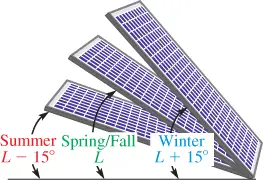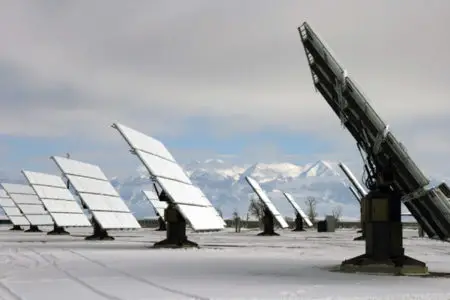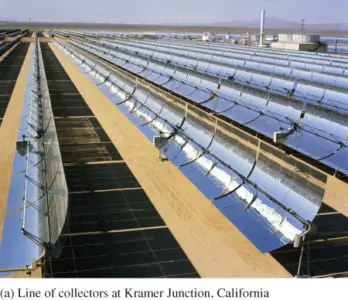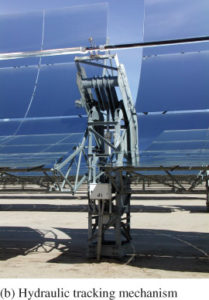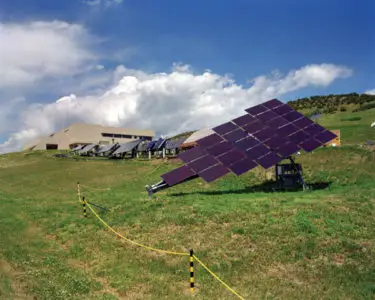Solar trackers increase the efficiency of solar systems by providing more direct sunlight on the collectors. Depending on the location and the specific system, 25% to 40% more energy can be harvested with tracking than without it.
Active and Passive Trackers
Solar trackers can be categorized as either active or passive.
Active Solar Tracker
An active tracker uses external power to move throughout the day from east to west.
Power is usually supplied to an electric motor to turn one or two axes; power can be obtained from the collector and stored in a battery for continuous tracking.
The tracker should position the collector to the east to be ready for the following day, so power needs to be available after the sun is down from a battery or from the utility grid for the reset operation.
Another type of active tracker is a hydraulic tracker, which requires electric power for the pump and for the controller.
Passive Solar Tracker
A passive tracker does not require external power to turn the axis (usually only one axis is used with this type of tracker).
One type of passive tracker uses a liquid, contained in canisters mounted on each side of the module that can turn easily into a vapor. Figure 1 shows the idea.
The canisters are connected together by a long tube and depend on the shifting weight of the liquid as they are heated by sunlight.
When the sun is shining and if one canister is shaded and the other is not, the liquid in the warmer tube vaporizes and forces more liquid into the shaded tube. The weight shifts and the tracker moves in a way that tends to equalize the temperatures and hence the weight.
Passive trackers are simple and do not need any external power, but they do not reset and are left in the evening facing west. It takes about an hour to move them back to the east the following morning in order to produce power, which is the time that an active tracker does not waste.
Thus, the passive tracker does not harvest quite as much of the available energy as an active tracker.
Figure 1 Passive Tracker. The collector moves as weight shifts between the canisters due to differential heating of the canisters.
Single-Axis Trackers
Many solar tracking devices have been developed. Single-axis control means only one axis automatically tracks the daily motion of the sun.
The seasonal changes in the sun’s path cannot be tracked automatically, but manual adjustments can be made to maximize the sunlight over the course of the year.
If an adjustment is done each season, the angle from the horizontal is typically set to the latitude −15° in the summer (flatter orientation) when the sun is high, 0° in fall and spring, and +15° in winter (steeper orientation) when the sun is low.
Figure 2 illustrates these seasonal tilt angles, in which the array faces south for the northern hemisphere and north for the southern hemisphere. (Ignore the negative sign for southern latitudes.)
Figure 2 Optimum Tilt Angle. The optimum tilt angle depends on the season. If the module can be adjusted four times per year, a shift of 15° each season from the latitude (L) is a good choice for maximizing energy.
When this tilt angle cannot be adjusted seasonally, the optimum angle depends on the latitude and climate conditions at the location as well as the user’s energy requirements (for example, summer irrigation).
In summer, the sun is in the sky longer than it is in the winter, and it is generally more likely to have clear skies; hence, much more energy is available during the summer.
For maximum energy intercepted over the course of a year, computer simulations of the weather are used to choose a tilt angle, and they generally favor a larger tilt angle to produce more power during the shorter winter days (December in the northern hemisphere; June in the southern hemisphere).
Altitude-Azimuth Trackers
Most trackers use an altitude-azimuth arrangement with a vertical axis and a horizontal axis.
The definition of altitude angle is the angle formed between a horizontal plane and an imaginary line pointed to the sun.
The azimuth angle is a horizontal angular distance from a reference direction, usually north. See Figure 3 for an illustration of the definitions for altitude and azimuth angles with reference to the sun.
For a single-axis tracker, the rotating axis is normally the vertical axis which moves the collector east to west during the day.
With the rotation on the vertical axis, the collector maintains a constant clearance from the ground. The collector is titled from the ground plane by an amount approximately equal to the latitude, and the collector is turned to the east in the morning and slowly turns to face west in the evening.
After sunset, active trackers reset to the east to be ready for the following day, but as mentioned previously, passive trackers require sunlight to reset.
Figure 4 shows an array of single-axis trackers that are driving flat panels. The vertical axis is the only one that tracks.
Figure 3 Altitude and Azimuth Definitions. The dotted line is the path of the sun on a certain day and location on earth.
Figure 4 Array of Collectors with Single-Axis Trackers. Notice the heavy support structure.
The path of the sun above the horizon is shortest in winter and longest in summer, so the turning arc is different for the trackers according to the season.
In some cases, the tilt for the PV panels on a single-axis tracker is adjusted manually to account for the seasonal changes in the sun’s motion.
Another type of single-axis tracker is shown in Figure 5. It uses mirrors to concentrate light on a pipe filled with synthetic oil. In this example, a single actuator can control an entire line of solar troughs that turn on a common axis.
The troughs are aligned along a north-south axis and are rotated to face the sun. During the day, the mirrors rotate from east to west to follow the sun across the sky; they reset back to the east in the evening to await the sun on the following morning.
A long array with one drive is an effective arrangement for a single-axis system. This array is a commercial power generation station at Kramer Junction, California.
The hot oil is pumped to a heat exchanger that has a water loop on the other side. This water is vaporized to steam that spins a turbine, producing electricity.
The same concept of one main driving system can also be applied to a line of flat-panel collectors.
Figure 5 Single-Axis Tracking for Trough Concentrating Collectors
The trough collectors are a form of non-imaging optics that have a wider angle of acceptance of the sun’s rays than do the imaging type of concentrators.
Non-imaging optics concentrate the radiation energy, but the goals are even illumination on a long target rather than on a small point and good heat transfer to the target. As mentioned, an array like this is ideally suited for single-axis tracking. In this case, both motor and hydraulic drives are used.
Figure 5b shows a hydraulic drive, which is located in the middle of the long trough and rotates the entire trough.
Equatorial Trackers
An equatorial tracker (sometimes called a polar tracker) is a variation of the horizontal-axis tracker where the rotating axis is tilted to be parallel with the earth’s axis (pointing due north in the northern hemisphere and due south in the southern hemisphere).
In a single-axis equatorial tracker, the panels are mounted so that they are perpendicular to the axis. Figure 6 shows solar panels mounted on an equatorial mount.
The panels are installed to avoid interfering with the motion of the array at sunrise and sunset. The arrangement of the mount shown is similar to the telescope mount on the famous Hale telescope on Palomar Mountain.
Figure 6 Equatorially Mounted Tracker
Dual-Axis Trackers
Certain concentrating collectors need better accuracy than a single-axis tracker can provide. The higher the concentration ratio, the higher the tracking accuracy that is required.
The highest accuracy is required by collectors that are so-called imaging types, such as the parabolic dishes used with Stirling engines. See Figure 7 for an example.
Imaging concentrating collectors work from direct radiation rather than diffuse radiation, and they are inefficient if they are not pointed directly at the sun.
To get the most energy and the highest temperature, dual-axis tracking must be employed. As the name implies, a dual-axis tracker can move in either of two directions.
Figure 7 Large Dual-Axis Tracker with a Stirling Engine
Generally, these trackers are set up as alt-azimuth mounts, meaning the axes move vertically (the altitude) and horizontally (azimuth). This reduces the issue of ground clearance, which can be a problem with equatorial mounts, but it requires a controller to make the adjustments in driving two motors.
In addition to the benefit for concentrating collectors, dual-axis tracking is sometimes used with flat collectors. A flat collector always receives the maximum amount of solar energy if it is oriented so that the direct radiation is perpendicular to its surface.
A dual-tracker moves the collector continuously during daylight hours to meet this condition, thus maximizing the solar energy harvested.
Thus, the main consideration when deciding to use single-axis, dual axis, or no tracking boils down to cost.
Most dual-axis trackers are active types and use two independent motors to turn the axis.
The most common method for moving a dual-axis tracker is stepper motors, which can be rotated precisely over some portion of an arc. The motors are controlled by a dedicated controller.
Various tracking algorithms have been written to provide solar coordinates for the controller; among the most accurate is one from NREL that can calculate the solar position over an 8,000-year period with uncertainties of ±0.0003°. Although this is far more accurate than would ever be needed by any solar tracker, it is useful for certain solar measurements, where a small part of the sun is imaged and tracked.
Review Questions
- For a single-axis tracker, what is the optimum angle to set the altitude angle for summer in Phoenix, Arizona (latitude 33.5° N)?
- Would you set a different angle if the angle is fixed and cannot be adjusted seasonally? Explain your answer.
- How would you orient a single-axis tracker for summer (in December) in Sydney, Australia (latitude 34° S)?
- Compare dual-axis tracking with single-axis tracking for a flat PV system. What are the primary selection criteria in choosing one or the other?
- Why does a Stirling engine collector require a dual-axis tracker?
Answers
- (a) Set it to 35.5° unless optimization for a particular season is desired.
- You can optimize the energy collected by making seasonal adjustments. Set the latitude angle for spring and fall. Set 15° lower in summer and 15° higher in winter.
- The basic tilt angle would be set for 19° facing north.
- A dual axis-tracker always collects more energy than a single-axis tracker, but for a flat plate, the additional energy collected may not outweigh the extra expense.
- The Stirling engine is an example of an imaging-type collector that requires high temperatures to be efficient. This is best accomplished with dual-axis tracking.

